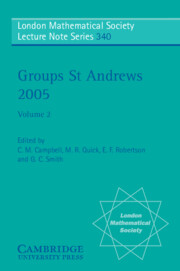Book contents
- Frontmatter
- Contents
- Introduction
- 1 Groups and semigroups: connections and contrasts
- 2 Toward the classification of s-arc transitive graphs
- 3 Non-cancellation group computation for some finitely generated nilpotent groups
- 4 Permutation and quasi-permutation representations of the Chevalley groups
- 5 The shape of solvable groups with odd order
- 6 Embedding in finitely presented lattice-ordered groups: explicit presentations for constructions
- 7 A note on abelian subgroups of p-groups
- 8 On kernel flatness
- 9 On proofs in finitely presented groups
- 10 Computing with 4-Engel groups
- 11 On the size of the commutator subgroup in finite groups
- 12 Groups of infinite matrices
- 13 Triply factorised groups and nearrings
- 14 On the space of cyclic trigonal Riemann surfaces of genus 4
- 15 On simple Kn-groups for n = 5, 6
- 16 Products of Sylow subgroups and the solvable radical
- 17 On commutators in groups
- 18 Inequalities for the Baer invariant of finite groups
- 19 Automorphisms with centralizers of small rank
- 20 2-signalizers and normalizers of Sylow 2-subgroups in finite simple groups
- 21 On properties of abnormal and pronormal subgroups in some infinite groups
- 22 P-localizing group extensions
- 23 On the n-covers of exceptional groups of Lie type
- 24 Positively discriminating groups
- 25 Automorphism groups of some chemical graphs
- 26 On c-normal subgroups of some classes of finite groups
- 27 Fong characters and their fields of values
- 28 Arithmetical properties of finite groups
- 29 On prefrattini subgroups of finite groups: a survey
- 30 Frattini extensions and class field theory
- 31 The nilpotency class of groups with fixed point free automorphisms of prime order
17 - On commutators in groups
Published online by Cambridge University Press: 20 April 2010
- Frontmatter
- Contents
- Introduction
- 1 Groups and semigroups: connections and contrasts
- 2 Toward the classification of s-arc transitive graphs
- 3 Non-cancellation group computation for some finitely generated nilpotent groups
- 4 Permutation and quasi-permutation representations of the Chevalley groups
- 5 The shape of solvable groups with odd order
- 6 Embedding in finitely presented lattice-ordered groups: explicit presentations for constructions
- 7 A note on abelian subgroups of p-groups
- 8 On kernel flatness
- 9 On proofs in finitely presented groups
- 10 Computing with 4-Engel groups
- 11 On the size of the commutator subgroup in finite groups
- 12 Groups of infinite matrices
- 13 Triply factorised groups and nearrings
- 14 On the space of cyclic trigonal Riemann surfaces of genus 4
- 15 On simple Kn-groups for n = 5, 6
- 16 Products of Sylow subgroups and the solvable radical
- 17 On commutators in groups
- 18 Inequalities for the Baer invariant of finite groups
- 19 Automorphisms with centralizers of small rank
- 20 2-signalizers and normalizers of Sylow 2-subgroups in finite simple groups
- 21 On properties of abnormal and pronormal subgroups in some infinite groups
- 22 P-localizing group extensions
- 23 On the n-covers of exceptional groups of Lie type
- 24 Positively discriminating groups
- 25 Automorphism groups of some chemical graphs
- 26 On c-normal subgroups of some classes of finite groups
- 27 Fong characters and their fields of values
- 28 Arithmetical properties of finite groups
- 29 On prefrattini subgroups of finite groups: a survey
- 30 Frattini extensions and class field theory
- 31 The nilpotency class of groups with fixed point free automorphisms of prime order
Summary
Abstract
Commutators originated over 100 years ago as a by-product of computing group characters of nonabelian groups. They are now an established and immensely useful tool in all of group theory. Commutators became objects of interest in their own right soon after their introduction. In particular, the phenomenon that the set of commutators does not necessarily form a subgroup has been well documented with various kinds of examples. Many of the early results have been forgotten and were rediscovered over the years. In this paper we give a historical overview of the origins of commutators and a survey of different kinds of groups where the set of commutators does not equal the commutator subgroup. We conclude with a status report on what is now called the Ore Conjecture stating that every element in a finite nonabelian simple group is a commutator.
Origins of commutators
“In a group the product of two commutators need not be a commutator, consequently the commutator group of a given group cannot be defined as the set of all commutators, but only as the group generated by these. There seems to exist very little in the way of criteria or investigations on the question when all elements of the commutator group are commutators.”
This is what Oystein Ore says in 1951 in the introduction to his paper “Some remarks on commutators”. Since Ore made his comments, numerous contributions have been made to this topic and they are widely scattered over the literature.
Information
- Type
- Chapter
- Information
- Groups St Andrews 2005 , pp. 531 - 558Publisher: Cambridge University PressPrint publication year: 2007
Accessibility standard: Unknown
- 10
- Cited by
